Why you can trust Tom's Hardware
The AW3821DW ships in its Standard picture preset with Eco mode turned on. This works with a room light sensor to vary brightness according to ambient light and limits output to conserve power. We disabled the sensor and the Eco mode for all testing, since it alters the results unpredictably.
Grayscale & Gamma Tracking
Our grayscale and gamma tests use Calman calibration software from Portrait Displays. We describe those our grayscale and gamma tests in detail here.
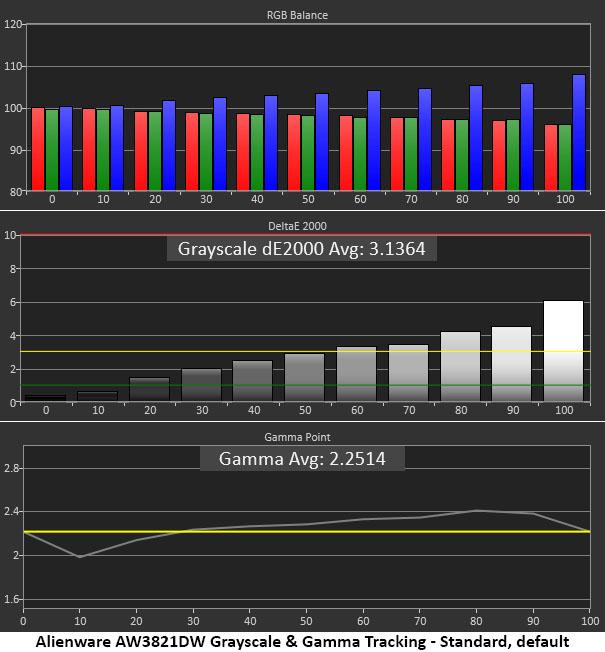
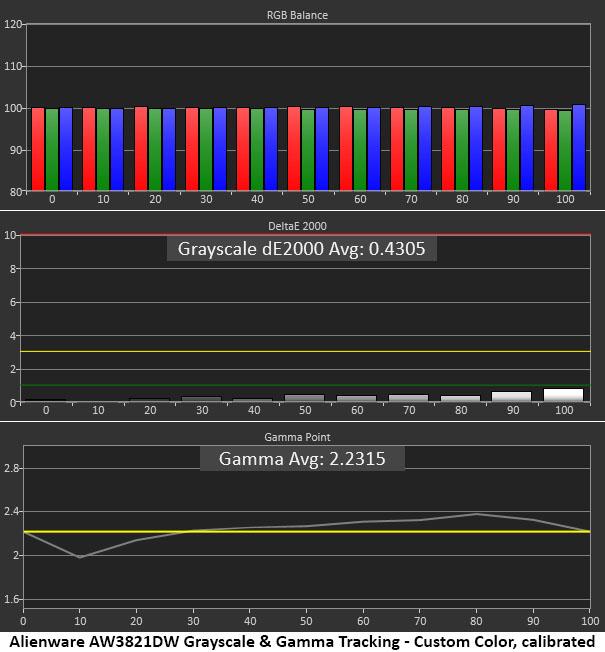
The AW3821DW’s initial grayscale measurement run isn’t too bad, but you will see a slight blue tint at 60% brightness and higher. The error is more visible as the picture becomes brighter. For most content, this is just within the realm of acceptability, but a premium monitor like this should come out of the box a little more neutral in tone.
Gamma is also a bit off the mark with a light spot at the 10% step and slightly dark highlight areas between 70 and 90%.
Our calibration resulted in near-perfect grayscale tracking with all errors less than 1 Delta E (dE). Gamma also improved slightly after calibrating, too but we’d prefer to see a flatter luminance trace. It’s a minor issue but one that shouldn’t be present in a premium display.
Comparisons
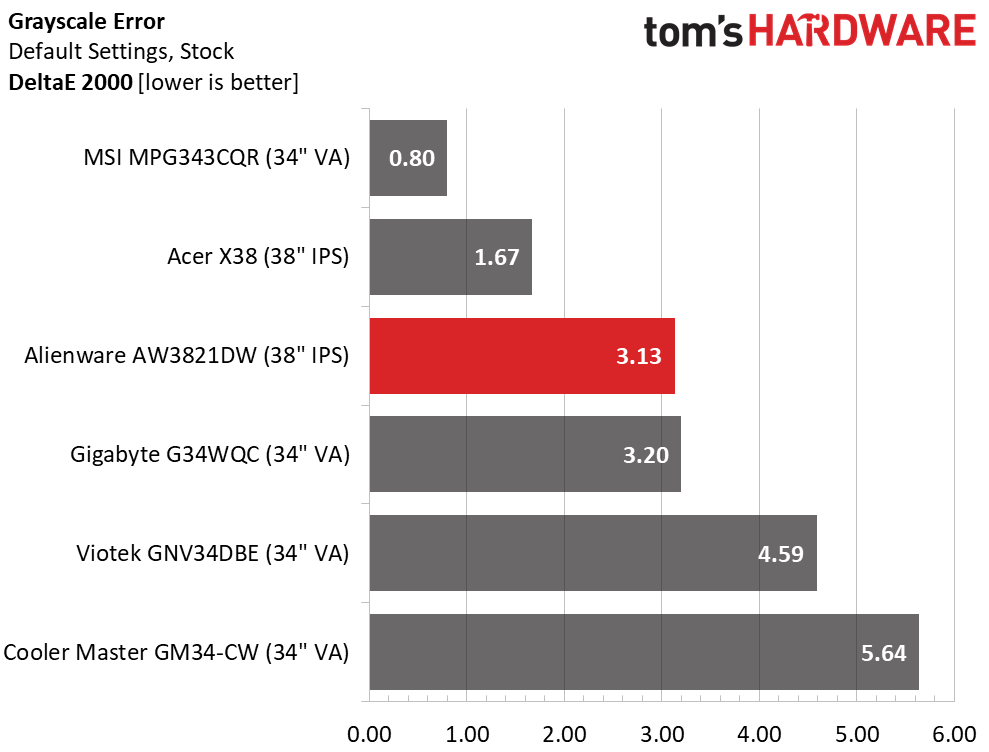
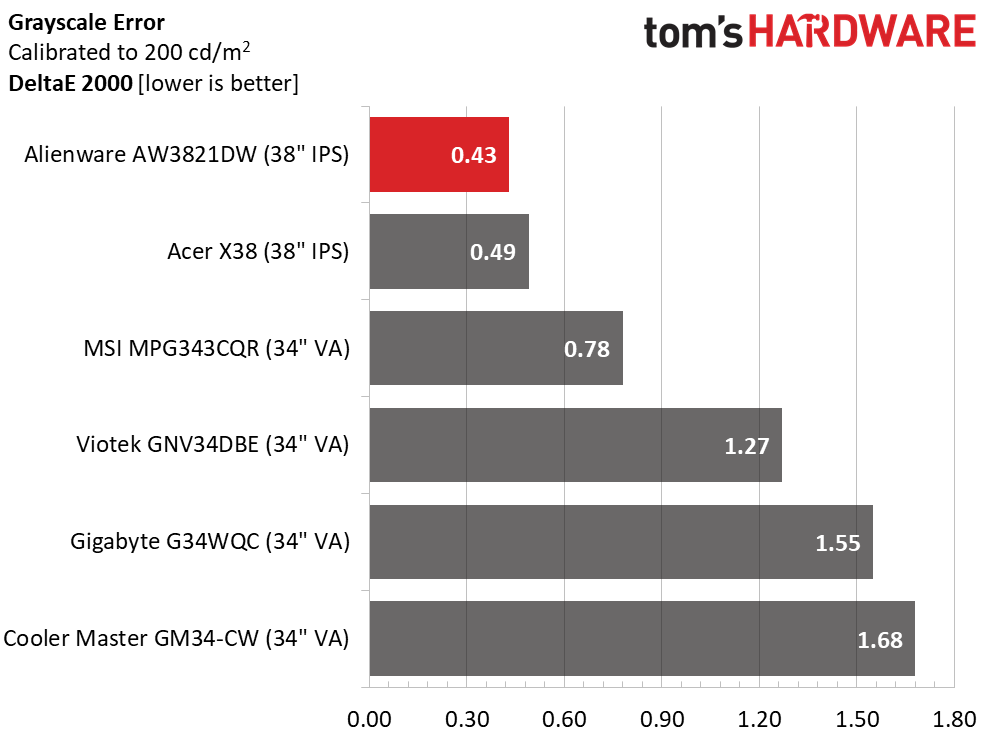
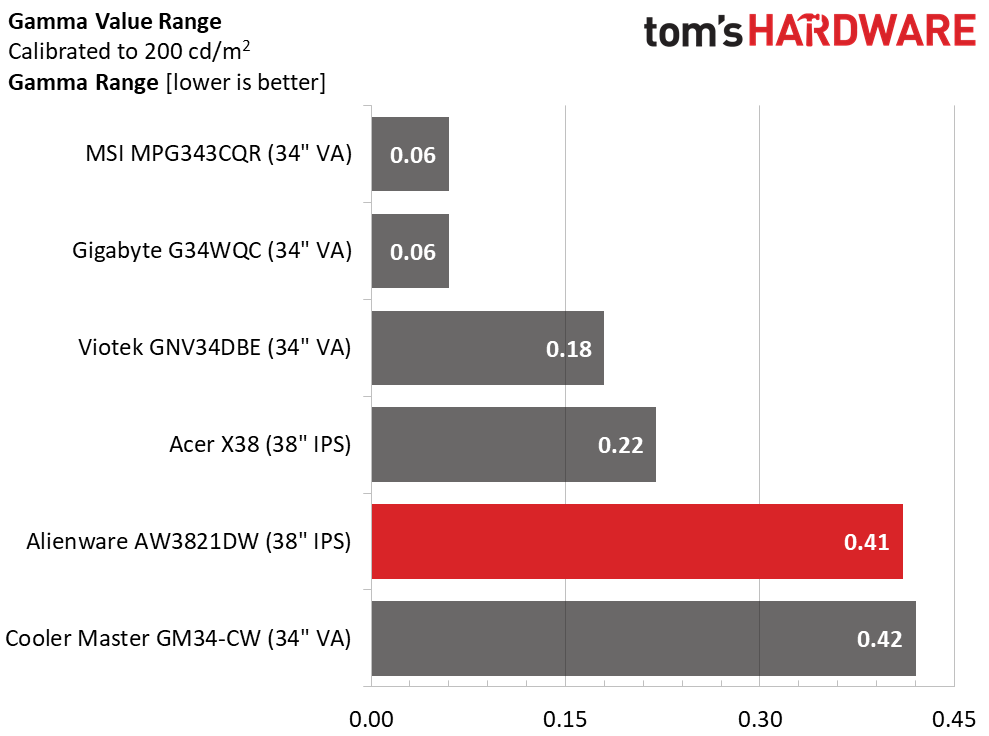
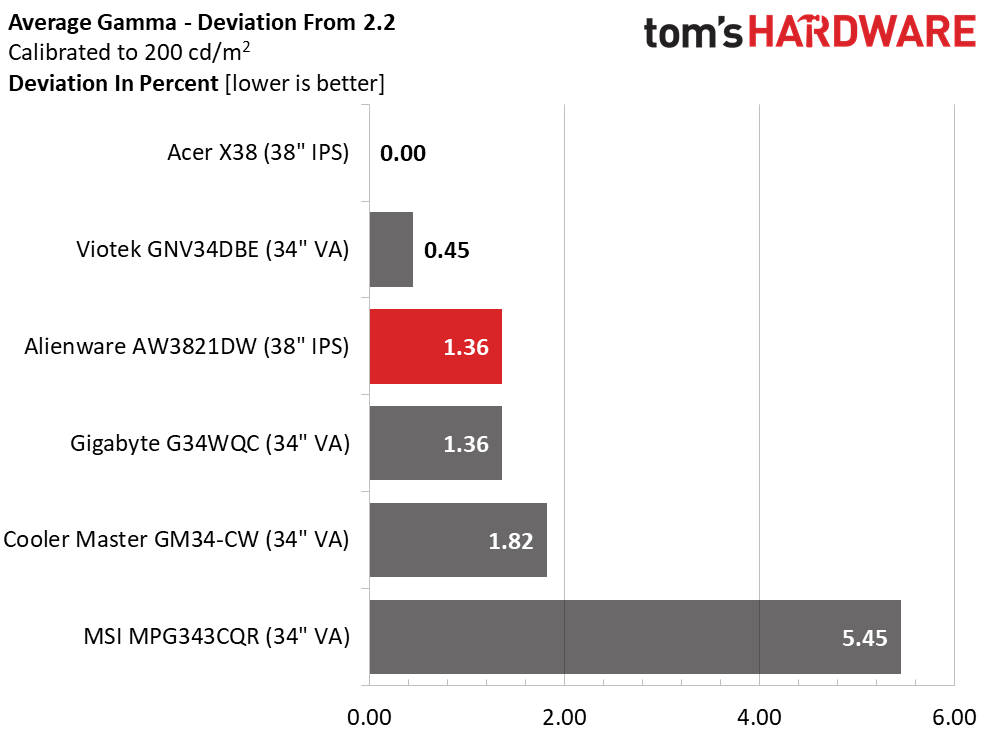
Though the AW3821DW acquits itself well among the other monitors here, its out-of-box performance is a little behind the Acer. You’ll have to decide whether it’s worth paying ~$300 more for the X38 to get a little better grayscale and gamma performance. But in the bigger picture, the Alienware performs well. Calibrated grayscale is at the top, and gamma isn’t too far off the mark with a 1.36% deviation from the 2.2 ideal.
Color Gamut Accuracy
Our color gamut and volume testing use Portrait Displays’ Calman software. For details on our color gamut testing and volume calculations, click here.
Get Tom's Hardware's best news and in-depth reviews, straight to your inbox.
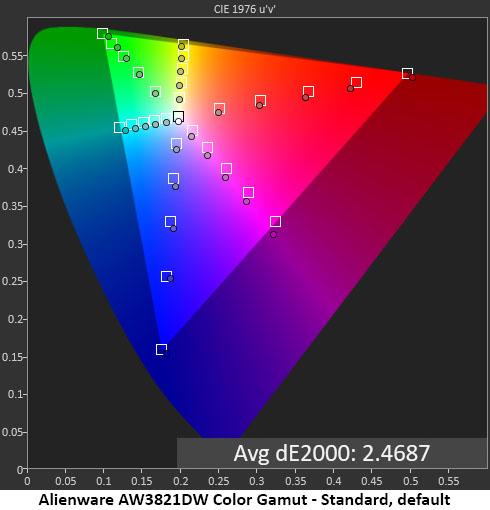
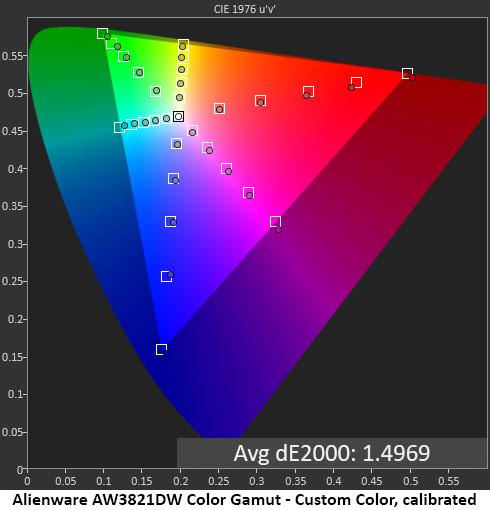
The AW3821DW’s out-of-box color gamut results are quite good. With an average error of just 2.47dE, there are no visible issues here. Red, magenta and cyan hues are slightly off, but this was almost impossible to spot in actual content. The DCI-P3 gamut is covered well with only slight undersaturation in green.
After our grayscale calibration, the chart looks even better with every point on target except green, which is still slightly undersaturated. But this is typical of extended color monitors. Only a tiny handful of displays can fully cover a DCI-P3 green primary.
Comparisons
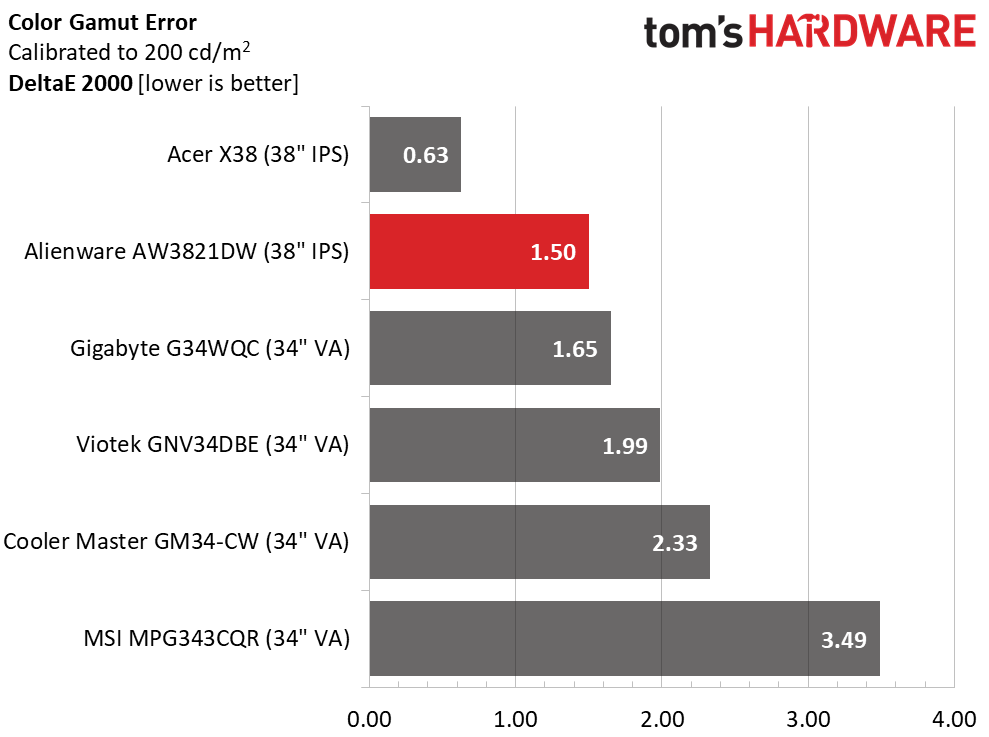
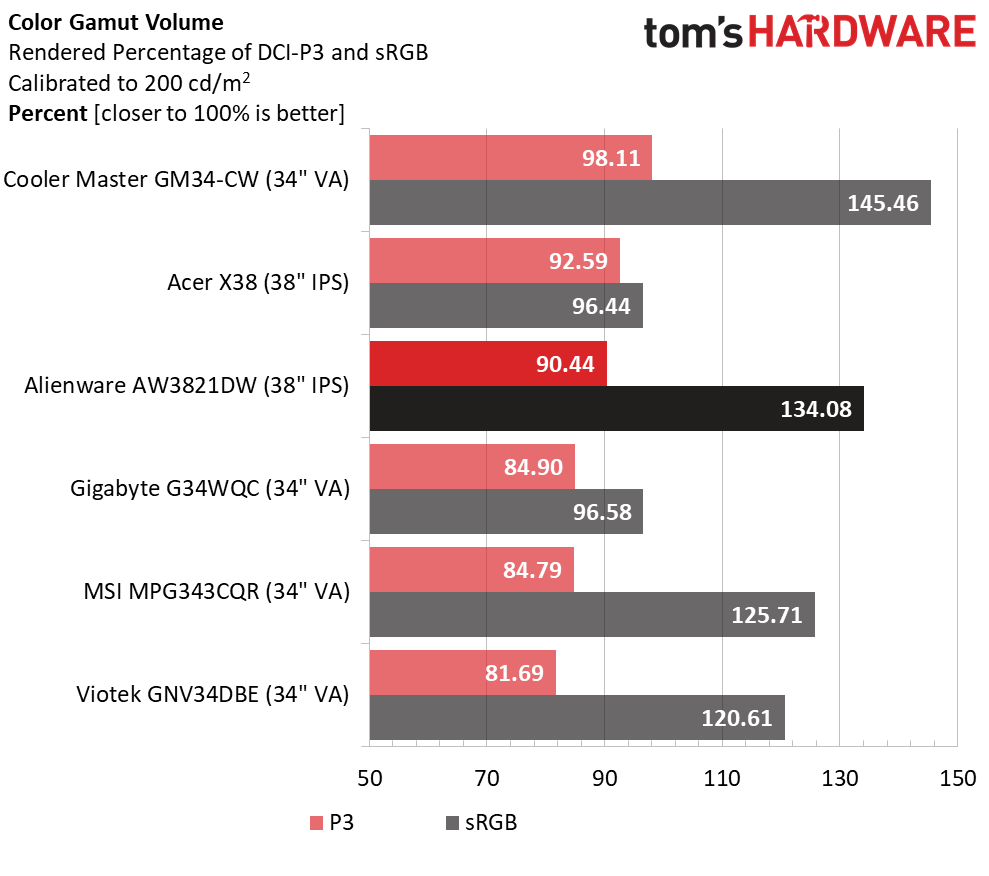
With a default color gamut error of 2.47dE average, the AW3821DW could make our Calibration Not Required list -- if its grayscale were a little better. But most will be satisfied with the default image in Standard mode. We recommend using our settings in Custom Color mode for the best possible picture. At 1.5dE, the final color error level is very low and only eclipsed by the Acer X38.
The X38’s extra cost will also buy you a bit more DCI-P3 gamut coverage, but that extra color will be very hard to spot in a side-by-side comparison. The Alienware’s 90.44% result is a very good number for any extended color display and definitely higher than average. You can also see that the X38 has an sRGB mode that affords it more accurate coverage of that smaller color space.

Christian Eberle is a Contributing Editor for Tom's Hardware US. He's a veteran reviewer of A/V equipment, specializing in monitors. Christian began his obsession with tech when he built his first PC in 1991, a 286 running DOS 3.0 at a blazing 12MHz. In 2006, he undertook training from the Imaging Science Foundation in video calibration and testing and thus started a passion for precise imaging that persists to this day. He is also a professional musician with a degree from the New England Conservatory as a classical bassoonist which he used to good effect as a performer with the West Point Army Band from 1987 to 2013. He enjoys watching movies and listening to high-end audio in his custom-built home theater and can be seen riding trails near his home on a race-ready ICE VTX recumbent trike. Christian enjoys the endless summer in Florida where he lives with his wife and Chihuahua and plays with orchestras around the state.
-
Metteec Overall, thank you for a well-detailed review. I think another important point to mention is the warranty. The Alienware includes Dell's 3-year advanced replacement, meaning Dell will send you a replacement before receiving your broken screen. With so many comparisons to the Acer X38p, having a 2-year standard warranty, I think that Tom's should mention the support differential. Another important factor not evaluated is the noise. The AW3821DW is whisper quiet. The X38p has a noticeable fan noise that I can hear with headphones on if no sound is playing. The sound was driving me crazy.Reply
I have owned the X38p (returned) and now I own the AW3821DW and can confirm the AW3821DW's HDR is mostly trash, but the color accuracy, screen size, g-sync, brightness, and responsiveness make it one of the best monitors I have used. I was able to purchase for around $1,300 in the US with a 10% off coupon and their sale. I would not be surprised if you saw the monitor get to $1000 in six months. -
helper800 Reply
At this price range you mind as well grab a 48 inch LG CX when they inevitably go on sale. I just recently got the 55 inch LG CX at Costco for 1350. I wall mounted it and have it at a -16 degree angle above my other 2 monitors. I have not used it for any PC gaming yet as I am setting up a new desk as well but it looks great about 5.5 feet away and all I have to do is look up about +40 degrees or lean back in my chair. It primary purpose is not PC gaming, however, its for the consoles and watching content from my bed about 10 feet away.coloradoblah said:About 600 too expensive still
TLDR; why get this monitor for nearly the price of something so much better? -
coloradoblah Reply
Yeah, im not a fan of non matte screens but the sheer size and contrast alone its a better buyhelper800 said:At this price range you mind as well grab a 48 inch LG CX when they inevitably go on sale. I just recently got the 55 inch LG CX at Costco for 1350. I wall mounted it and have it at a -16 degree angle above my other 2 monitors. I have not used it for any PC gaming yet as I am setting up a new desk as well but it looks great about 5.5 feet away and all I have to do is look up about +40 degrees or lean back in my chair. It primary purpose is not PC gaming, however, its for the consoles and watching content from my bed about 10 feet away.
TLDR; why get this monitor for nearly the price of something so much better? -
helper800 Reply
It has a glossy finish but its bright enough to get rid of about 80% of glare. It was a big concern of mine but I am happy with the finish in the end. I have had some monitors with matte finishes that end up making the picture overall grainy looking which, in my opinion, is worse than glare.coloradoblah said:Yeah, im not a fan of non matte screens but the sheer size and contrast alone its a better buy -
TacticalBeard Just grabbed this for 1100$ for Black Friday 2021.Reply
ive been using a 100hz 3440x1440 acer predator x34 since it’s been out 6 years now. Got lucky and grabbed it for a 700$ Open box steal back when they were new and everyone was sending them back because they had IPS glow in the corners.
this has much faster nano IPS,144 refresh rate , slightly bigger at 38” but with the same pixel density being 3840x1600 21.45% more pixels the GPU needs to run but still keeping a 21:9 aspect ratio unlike the 49” Samsung G9 that’s it’s own uniqe aspect ratio that I doubt has much if any game support you
It’s a solid improvement in IPS panel technology. I’ve never had an HDR screen so I’ll have to wait and see if I like this. even if it’s only HDR600 witch really seems to be the only real let down of this screen with pretty much every reviewer saying 1000HDR is when it starts to get good it makes me wonder why dell ddt push to make this premium display to have the last thing it needed to be perfect and left it with mediocre HDR . But for all I know 600HDR will blow me away when I first try it
just need to figure out what I’m going to do with my x34 that’s still running perfectly fine